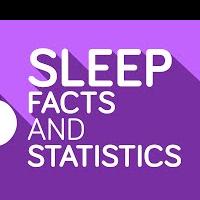Sleep Facts and Statistics
|||통계
睡眠|||
Fakten und Statistiken zum Schlaf
Datos y estadísticas sobre el sueño
수면 관련 사실 및 통계
Feiten en statistieken over slaap
Fakty i statystyki dotyczące snu
Factos e estatísticas sobre o sono
Факты и статистика сна
Uyku Gerçekleri ve İstatistikleri
Факти та статистика про сон
睡眠事实和统计数据
睡眠事实与统计
Sleeping is a daily process that should take seven to nine hours a night.
To feel fresh when waking one must sleep uninterrupted throughout the night.
||||||||끊임없이|||
||||||||безперервно|||
||||al despertar|uno debe||dormir|sin interrupciones|||
目を覚ますときに新鮮に感じるためには、一晩中途切れることなく眠らなければなりません。
thirty nine percent of adults receive less than the recommended seven hours.
|||||||||recommended||
成人の39%が、推奨される7時間未満しか受け取りません。
The amount of sleep needed is dependent of the individual and our age.
必要な睡眠の量は、個人と年齢によって異なります。
ideally we sleep enough so that we are able to wake without an alarm clock.
理想的には、目覚まし時計なしで目覚めることができるように十分に眠ります。
sleepiness arrives in relation to the amount of time we are awake.
сонливость наступает в зависимости|||||||||||
졸림|||||||||||
somnolencia|||||||||||
眠気は私たちが起きている時間に関連して到着します。
睡意的产生与我们清醒的时间有关。
It’s also controlled by our biological (circadian) clock making humans alert while it is light outside and sleepy by night.
||||||циркадный|||||||||||||
||||||zirkadian|||||||||||||
||||||biological clock|||||||||||sleepy||
||||||circadiano|||||||||||||
また、私たちの生物学的(概日時計)によって制御されており、夜間は外が明るく眠い間は人間に注意を促します。
REM or rapid-eye movement and NREM or non rapid-eye movement switch every ninety minutes during a normal night’s sleep.
||||||БДГ-сон||||||||||||||
||||||||||||cambio||||||||
||||||NREM||||||||||||||
通常の夜の睡眠中は、90分ごとにREMまたは急速眼球運動とNREMまたは非急速眼球運動が切り替わります。
在正常的夜间睡眠中,REM 或快速眼动和 NREM 或非快速眼动每九十分钟切换一次。
this process is called sleep architecture.
|||||구조
NREM has 4 stages.
As we linger between sleep and wakefulness we are in stage one.
||задерживаемся||||бодрствование|||||
||verweilen||||Wachsamkeit|||||
||||||각성|||||
||permanecemos||||vigilia|||||
||ficamos|||||||||
睡眠と覚醒状態の間で長引くと、ステージ1になります。
In stage two cognizance of our surroundings disappears.
|||осознание||||
|||awareness||||
|||consciência||||
|||das Bewusstsein||||
|||인지||||
|||認識||||
|||conciencia|||entorno|
ステージ2では、周囲の認識が消えます。
在第二阶段,我们对周围环境的认知消失了。
Also body temperature decreases.
|||sinkt
|||lowers
体温も下がります。
The deepest part of sleep makes up stages three and four.
|||||составляет|||||
|más profunda|||||||||
Самая глубокая часть сна составляет стадии три и четыре.
At this point, we enter restorative sleep.
|||||erholsamen|
|||||healing|
|||||restaurador|
この時点で、回復睡眠に入ります。
На этом этапе мы входим в восстановительный сон.
We re-energize, allow hormones for growth and development to release, blood pressure drops and our breathing become slower.
||заряжаемся энергией||||||||||||||||
|re|||||||||||||||||
||re-energizamos|permitimos que|hormonas|para|crecimiento||desarrollo||se liberan|||disminuye|||respiración||más lento
||reativar||||||||||||||||
Мы восстанавливаемся, позволяем гормонам роста и развития высвобождаться, кровяное давление падает, и наше дыхание замедляется.
我们重新充满活力,释放生长发育所需的激素,血压下降,呼吸变得更慢。
REM.
Our brains are active at this time and dreams occur.
Our bodies relax and breathing and heart rate may fluctuate.
|||||||||колебаться
|||||||||fluktuieren
|||||||||변동하다
According to a 2002 poll in America, seventy five percent adults have sleeping problems a few times in any given week.
|||poll||||||||||||||||
|||encuesta|||||||||||||||dada|semana
||||||семьдесят|||||||||||||
In the united states around one hundred thousand vehicle crashes a year are sleep related.
|||||||||crashes|||||
||||||cien||||||||relacionados con el sueño
在美国,每年约有十万起车祸与睡眠有关。
These accidents make up 1500 deaths.
||составляют||
||constituyen|constituyen|
Эти несчастные случаи приводят к 1500 смертям.
Insomnia is a disorder which prevents a person from falling asleep, staying asleep or having a non-refreshing sleep.
insomnia|||疾病|||||||||||||||
Insomnia||||||||||||||||||
不眠症は、人が眠りにつくこと、眠り続けること、またはさわやかな眠りにつくことを妨げる障害です。
Бессонница - это расстройство, которое мешает человеку засыпать, оставаться спящим или иметь неосвежающий сон.
失眠症是一种使人无法入睡、无法维持睡眠或睡眠质量不佳的疾病。
Up to forty percent of adults have insomnia throughout a year.
|||||Erwachsene|||||
До сорока процентов взрослых страдают бессонницей в течение года.
One-third of people will suffer from insomnia at some point.
|un tercio|||||||||
Ninety percent of those suffering from depression suffer from insomnia.
||||||depression|||
تسعون في المئة من الذين يعانون من الاكتئاب يعانون من الأرق.
うつ病に苦しんでいる人の90%が不眠症に苦しんでいます。
Bad dreams are common at all ages unlike night terrors.
|||||||||кошмары
|Träume|||||||Nacht|ängste
||||||||night|terrors
|||||||||terrores
Les mauvais rêves sont fréquents à tous les âges contrairement aux terreurs nocturnes.
夜の恐怖とは異なり、悪い夢はすべての年齢で一般的です。
Плохие сны встречаются в любом возрасте, в отличие от ночных ужасов.
Night terrors are characterized by: screaming, kicking, panicking, sleepwalking, trashing and talking.
||||||пинание|||беспокойные движения||
|||||||||Zappeln||
|||||||||thrashing||
|||||||||jogando coisas||
||||||patadas|entrando en pánico|sonambulismo|agitación violenta||hablar
Les terreurs nocturnes se caractérisent par: des cris, des coups de pied, de la panique, du somnambulisme, des ordures et des paroles.
夜間恐怖症の特徴は、叫び、蹴り、パニック、夢遊病、トラッシング、話し合いです。
Ночные ужасы характеризуются: криком, пинками, паникой, сомнабулизмом, буйством и разговорами.
夜惊的特征是:尖叫,踢腿,惊慌,梦游,乱扔垃圾和说话。
Night terrors are normal until age 6.
Ночные кошмары|||||
||||bis|
夜間恐怖症は6歳まで正常です。
Ночные ужасы считаются нормальными до 6 лет.
18% of people are susceptible to sleepwalking.
|||восприимчивы к лунатизму||
|||||Schlafwandeln
|||likely to experience||
人々の18%は夢遊病にかかりやすいです。
Most are children.
ほとんどは子供です。
Boys are more prone than girls to sleep walk.
|||anfällig|||||
|||more likely|||||
|||propensos|||||
男の子は女の子よりも睡眠をとる傾向があります。
Want to sleep better?
よりよく眠りたいですか?
Pass on, caffeine, alcohol and nicotine.
Откажитесь от|||||
pasa|||||
تمرير ، والكافيين والكحول والنيكوتين.
カフェイン、アルコール、ニコチンを渡します。
不要摄入咖啡因、酒精和尼古丁。
Exercise often but not before your proposed bed time.
||||||vorgeschlagenen||
ممارسة الرياضة في كثير من الأحيان ولكن ليس قبل وقت النوم المقترح.
Trainieren Sie oft, aber nicht vor Ihrer vorgeschlagenen Schlafenszeit.
頻繁に運動しますが、就寝前に運動します。
Narrated by Erica Laba.
Озвучено Эрикой Лаба.||Эрика|Лаба
Erzählt|||
|||narrado por Erica Laba
رواه إيريكا لابا.
Animated by Andrey preston Follow The Infographics Show on Twitter (@theinfoshow) and facebook also sending your suggestions on what you would like to see in the future episodes.
|||Престон|||||||шоу инфографики|||||||||||||||||
||Andrey|Preston|||||||theinfoshow|||||||||||||||||
Andrey prestonによるアニメーションTwitterのインフォグラフィックショー(@theinfoshow)とFacebookでフォローして、今後のエピソードで見たいものについての提案を送信してください。
动画由 Andrey preston 制作,在 Twitter (@theinfoshow) 和 Facebook 上关注 The Infographics Show,还可以发送您希望在未来剧集中看到的内容的建议。
Don’t forget to leave us a comment on www.SuprNova.org
|||||||||SuprNova|
|||||||||SuprNova|
www.SuprNova.orgにコメントを残すことを忘れないでください

